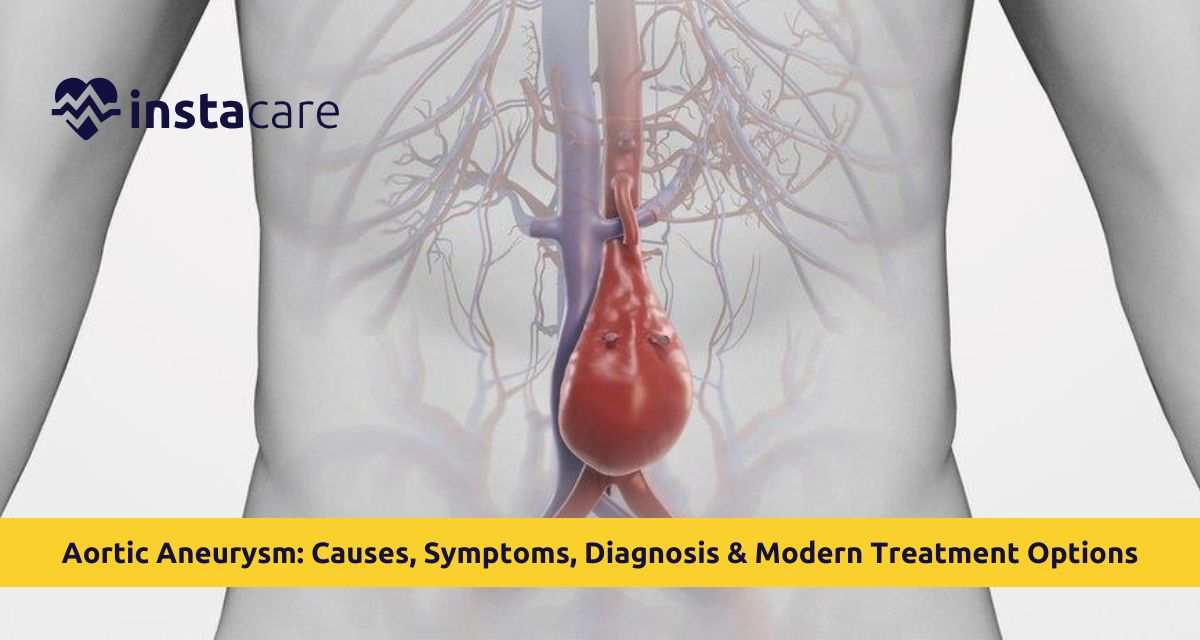What Is an Aortic Aneurysm?
An aortic aneurysm happens if the main artery swells past normal limits. When blood moves out of the heart, thin spots might puff outward instead. Though some stay small, others grow slowly, raising chances of burst or tear, either one possibly deadly.
Types of Aortic Aneurysms
Two primary kinds of aortic aneurysm exist, grouped by where they occur
Abdominal Aortic Aneurysm (AAA)
- Found in the section of the aorta passing through the belly region.
- Typical in males, frequently linked to tobacco use.
- Often, situations seem fine, then unexpectedly fall apart.
Thoracic Aortic Aneurysm (TAA)
- Positioned within the chest area of the aorta.
- May include hereditary elements; also, issues like hypertension or weaknesses in connective structures.
- Might lead to chest pressure, discomfort radiating to the spine, also trouble inhaling deeply.
Different forms impact the aortic arch or spread through the torso; however, abdominal aortic aneurysm and chest instances occur more often. Understanding types of aortic aneurysm helps identify location and severity.
Causes and Risk Factors of Aortic Aneurysms
Finding the reasons behind aortic aneurysm causes could lead to earlier detection or prevention. Listed below are frequent causes
- Atherosclerosis stiffens arteries, therefore, the aortic wall gradually deteriorates.
- High blood pressure causes steady strain on artery linings.
- Genetic aspects play a role, disorders such as Marfan or Ehlers-Danlos can increase likelihood. However, inherited background influences outcomes too. In certain cases, gene differences heighten chances. Due to this, particular health issues gain importance.
- Males tend to receive an AAA more often. Although age is crucial, sex also matters.
- Smoking increases the risk of aneurysms, one key factor. Still, making changes to daily habits can help avoid it.
- Infections or injuries: At times, damage to the aorta from illness or trauma may result in aneurysms, uncommon, but possible. If diseases compromise the vessel's structure, strong impacts could have similar effects. Though seldom seen, such triggers pose risks under certain conditions.
Risk factors for aortic aneurysm involve genetics, elevated cholesterol levels, excess body weight, or ongoing vessel irritation. Individuals facing such issues might gain value from routine screenings, particularly males with prior smoking history.
Signs and Symptoms of Aortic Aneurysms
Some people have mild signs, or no noticeable issues, until the inflammation grows or bursts. Typical hints for aortic aneurysm symptoms might be:
- Pain returns occasionally, mostly in the lower back, now and then moves to the chest or extends toward the abdomen
- Pulsing feeling around the belly button, sometimes tied to swelling of a major blood vessel
- Breathing issues or difficulty eating (with TAA)
- Hoarseness may occur; similarly, coughing can appear when the aneurysm impacts adjacent nerves or breathing passages
A sharp outbreak may bring intense pain, lightheadedness, poor blood flow, risky if treatment's delayed; spotting initial signs matters because of this. However, acting fast improves outcomes significantly. An aneurysm rupture requires immediate medical attention.
How Aortic Aneurysms Are Diagnosed?
Aortic aneurysm diagnosis usually shows up on scans because symptoms aren't there at first; for this reason, physicians choose ultrasound or CT instead of X-ray
- Ultrasound spots AAA well because it shows clear pictures; for this reason, doctors often use it.
- CT scans provide detailed images of the aorta, commonly chosen where accuracy counts. Yet caution remains necessary because of radiation exposure, though they support correct diagnosis.
- MRI pinpoints the bulge's location, also indicates its dimensions. Using powerful magnets, it produces sharp visuals inside the body; completely skips radiation exposure.
- Chest X-ray: Occasionally spots thoracic aortic aneurysm by chance.
- Echocardiography checks the aortic root while measuring the ascending section; it assesses one area even as it reviews another.
Routine aortic aneurysm screening for aortic swelling is advised in higher-risk populations, particularly older men who smoke. Spotting it early greatly lowers chances of rupture.
Treatment Options for Aortic Aneurysm
The approach to managing aortic aneurysm treatment relies on how big it is, how fast it's growing, where it's located, alongside the patient's general condition. Possible steps might involve:
Monitoring and Lifestyle Changes
- Small bumps under one cm might need ongoing checks.
- Blood pressure management supports heart health; stopping cigarettes improves outcomes while proper eating reinforces every area.
Surgical Treatments
- Open aneurysm repair removes damaged parts, replacing these using artificial grafts. When bulges are big or uneven, this approach often works.
- Endovascular aneurysm repair (EVAR) involves inserting a stent graft into blood vessels, this method causes less trauma than traditional surgery. Recovery tends to be quicker because only small cuts are made. Risks decrease due to minor wounds along with reduced effect on nearby areas.
Emergency Intervention
Needed when an aneurysm bursts or the aorta tears suddenly. Quick aortic aneurysm surgery may lead to survival. Aortic dissection is another serious complication requiring immediate surgical intervention.
Improvements in EVAR, along with mixed techniques, raised survival numbers while cutting recovery time, so treatments now work better and more consistently. Newer approaches speed up healing compared to earlier ones, due to greater precision during surgery. Current care relies on minimally intrusive methods, lowering aortic aneurysm complications in blood vessel repairs.
Prevention and Lifestyle Recommendations
Stopping an aortic aneurysm means handling risks while living in ways that support heart health. Aortic aneurysm prevention includes:
- Avoid smoking, likewise, stay away from passive inhalation.
- Maintain steady blood pressure, also keep cholesterol under control.
- Exercise regularly, it strengthens your heart. Yet doing it daily helps circulation too.
- Have meals with plenty of fruit; try mixing in veggies, at the same time bringing in whole grains.
- Check regularly for aortic widening when danger goes up.
- Follow your doctor's guidance when dealing with diabetes, just like you would with high blood pressure or another ongoing health issue.
A basic everyday schedule, paired with regular health checks, reduces chances of serious issues. Simple actions linked to screenings help avoid major illnesses. Sticking to steady routines while booking appointments lowers dangers.
Conclusion
An aortic aneurysm can turn severe, usually showing no signs until problems arise. Knowing the kinds, causes, or slight red flags boosts the likelihood of spotting it early, making prompt care possible. Today's treatments, such as EVAR or surgery, along with better prevention methods, lead to stronger recovery rates. Routine screenings combined with daily habit changes support lasting cardiovascular wellness.
Please book an appointment with the
best Cardiologist in Lahore, Karachi, Islamabad, and all major cities of Pakistan through
InstaCare, or call our helpline at 03171777509 to find the verified doctor for your disease.

